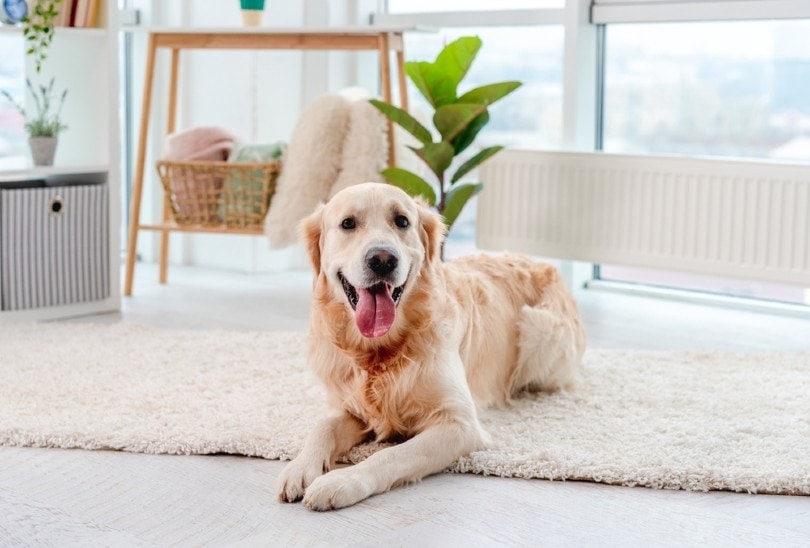Labradoodle vs. Goldendoodle: What’s the Difference?
Updated on
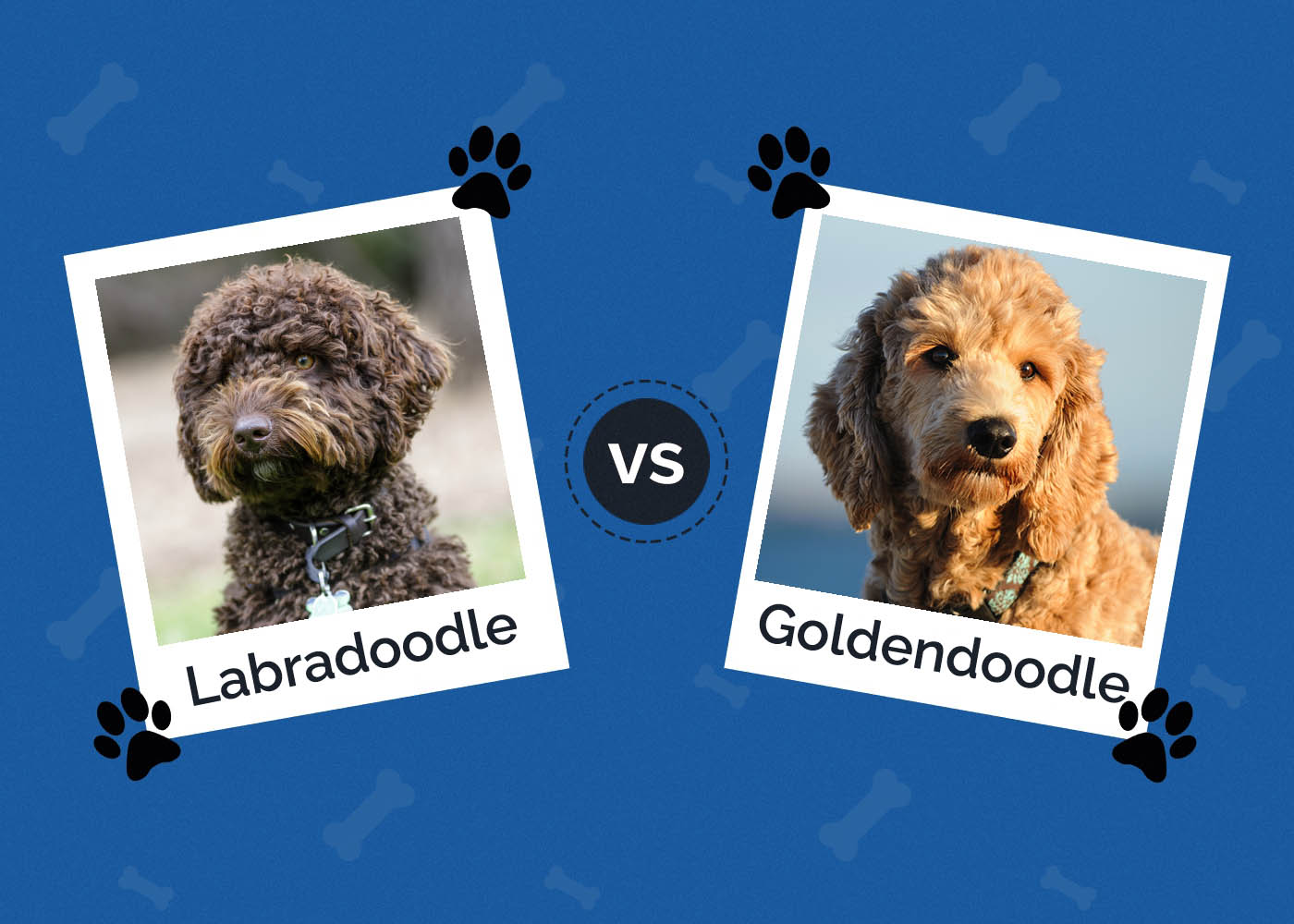
At a glance, the Labradoodle and Goldendoodle can appear very similar. After all, they are mixed breeds of the Poodle, which means they will share a lot of the same traits. However, they do get some differences from their other parents.
Both of these breeds are bred primarily to be companion dogs. They are both relatively active family dogs that are known for their affectionate nature and friendliness. These are the sort of dogs that books are written about. They are suitable for a wide range of families thanks to their low maintenance and friendly temperament.
However, these two mixed breeds have some slight differences. One might be better for your family than the other. How does Labradoodle vs Goldendoodle size compare, for example? Our comparison below of Labradoodle vs Goldendoodle should help you decide which breed would be better for your particular situation.
Labradoodle vs Goldendoodle: Visual Differences
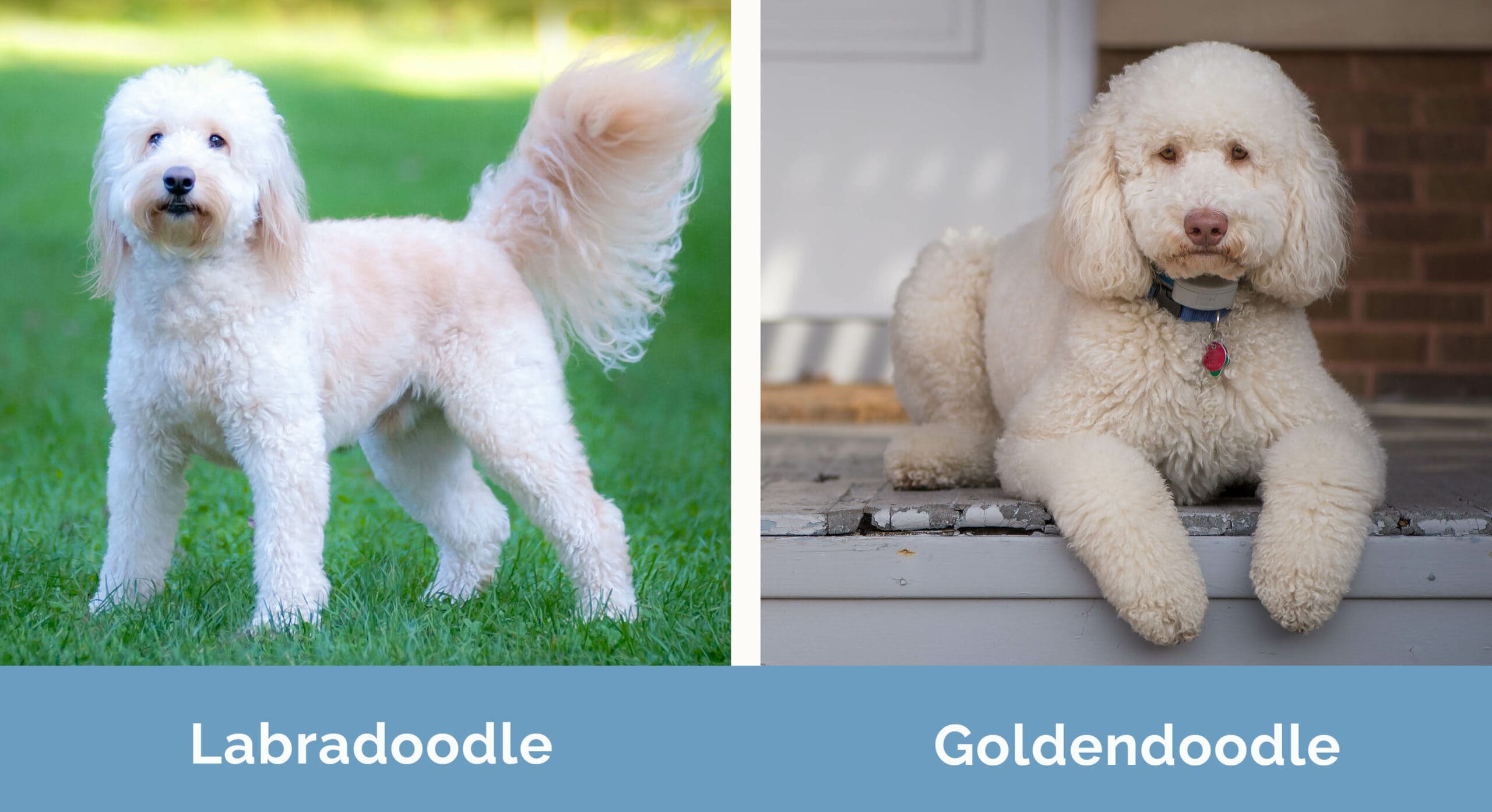
A Quick Overview
- Average height: Three Sizes; 9 – 19 inches
- Average weight: Three Sizes; between 15-100 pounds
- Lifespan: 12-16 years
- Exercise: Moderate
- Grooming needs: Moderate
- Family-friendly: Yes
- Dog-friendly: Yes
- Trainability: Intelligent and eager
- Average height: 17-19 inches
- Average weight: 40-70 pounds
- Lifespan: 12-16 years
- Exercise: Moderate
- Grooming needs: Low
- Family-friendly: Yes
- Dog-friendly: Yes
- Trainability: Eager to please
Labradoodle Overview
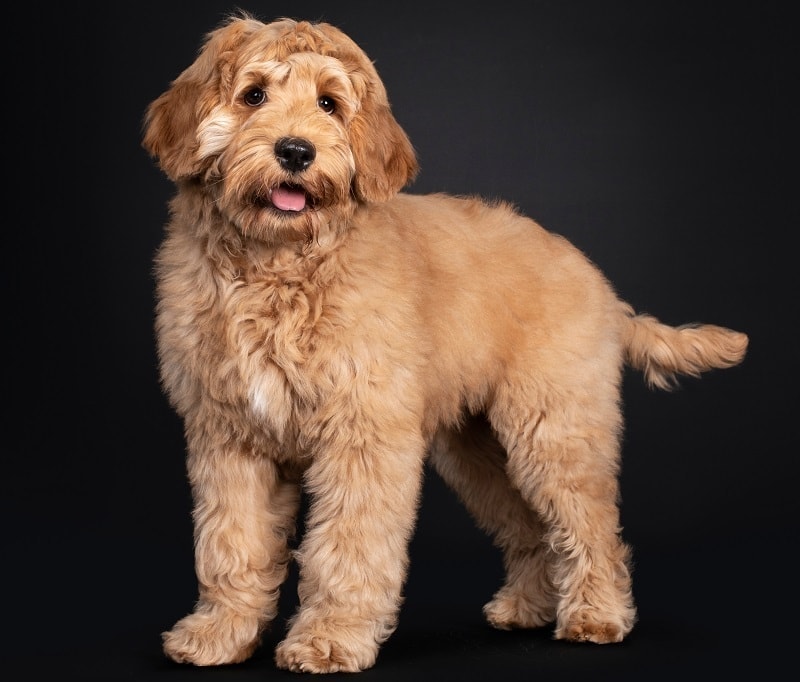
The Labradoodle is a mixed breed between a Labrador and a Poodle. Because it is a mixed breed, you never really know what you’re going to get. The traits and temperament are not as set as a purebred since the puppy can inherit any parent trait.
Poodles come in three different sizes. The size of the Labradoodle will depend on their Poodle parent’s size. Some can be relatively small, while others can weigh up to 100 pounds. To figure out the size of a particular Labradoodle, ask about the size of their Poodle parent. Of course, because this is a crossbreed, the puppy’s particular size might not be similar to the Poodle parent at all. Instead, the dog might take after the Labrador parent.
Labradoodles are quite active. Both parents are working dogs, which means that they have high endurance. Usually, they need quite a bit of exercise because of this. They are best for active families and those who have plenty of time to exercise them. They love to participate in canine sports like agility, frisbee, and obedience.
Labradoodles are sometimes described as “hypoallergenic,” but this isn’t always true. When someone is allergic to a dog, they are reacting to the dander. All dogs produce dander, so there is no hypoallergenic dog. However, dander tends to catch a ride on loose hair. If a dog doesn’t shed particularly bad, then the dander won’t travel as far. However, a sensitive person will still react to the pet’s dander.
Labradoodles cost anywhere from a few thousand dollars to a few hundred dollars. Some high-class breeders will charge lots for their dogs, though you may be able to find these dogs at a local shelter for much cheaper.
Temperament
Typically, Labradoodles are very friendly. However, this depends on the particular traits they inherited from their parents and the environment they were raised in. In the end, there are so many factors that go into a Labradoodle’s personality that it can be nearly impossible to predict how they will act.
When socialized and trained correctly, Labradoodles are typically very loveable and devoted to their family. They may be a bit aloof like their Poodle parent, but they should never be aggressive or wary of people. Early socialization is essential to ensure that they are accepting of many different people.
These dogs are quite intelligent. They need a bit of mental stimulation to remain happy and healthy. Many will get destructive when they are bored, so it is often in your best interest to wear them out. Puzzle toys, training, and canine sports are all reliable ways to exercise your pet’s brain.

Training
Because of their high intelligence, these dogs are relatively easy to train. They are eager to please and are not particularly stubborn. Positive training techniques are always the way to go. Start young and train often. Regular training will keep these dogs happy and prevent them from becoming bored. Plus, they’ll also learn how to be well-behaved.
Puppy classes as soon as puppy shots are done are recommended. This will introduce the dog to various other dogs and people, which will help them become more friendly and accepting of others. At the same time, they will also learn a few tricks and commands, which will help you keep them under control.
The Labradoodle does tend to have a stubborn streak around one year of age. This is common amongst many dog breeds. However, if you stick with it, they typically calm down as they move into adulthood. It is their “teenager” phase.
Care and Health
As a mixed breed, these dogs are incredibly healthy. They are not prone to any particular health conditions and usually live longer than either of their parents. The smaller dogs tend to outlive the larger dogs, which is shared amongst all dog breeds.
Usually, the most common problems are hip dysplasia and other joint disorders. These are most common in larger dogs, as they put more weight on their joints and grow faster. These problems are partially genetic, so you should ensure that the parents have undergone joint testing before breeding.
Diet can play a role as well, especially for bigger dogs. You must choose a puppy food that is suitable for the dog’s size. More giant puppies need more nutrition than smaller puppies, so be sure that the puppy food you choose is designed to handle larger dogs.
This mixed breed can have a few types of fur. They may have fur like a Poodle or fur like a Labrador Retriever. In all likelihood, they will probably look like something in-between. How you groom them depends on their fur type. Some may need to make regular visits to the groomers for a trim, while others may need to be brushed to control the shedding.
Goldendoodle
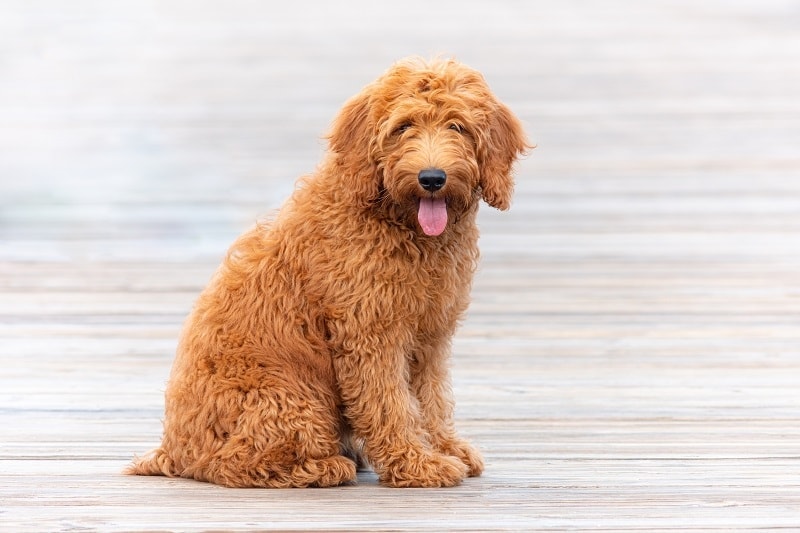
The Goldendoodle is a mix between a Golden Retriever and a Poodle. Since these dogs share one parent with the Labradoodle, they can be quite similar. Once again, their size can vary quite a bit depending on the size of Poodle. If a miniature Poodle is used, they may be as small as 20 pounds. Larger, Standard Poodles may have puppies that weigh upwards of 80 pounds.
Be sure to ask about the size Poodle used to produce the puppies to ensure you know what size puppy to expect. As you might imagine, the size won’t always line up precisely since the Golden Retriever’s genes are involved as well.
These dogs have moderate activity needs. Both the Golden Retriever and the Poodle are working dogs with high amounts of stamina. These dogs require daily exercise to remain fit and happy. Otherwise, they may become destructive.
Because both of their parents are intelligent, these puppies will likely be too. They need a bit of mental stimulation through puzzle toys or training. Otherwise, they may try to make their fun, which usually means tearing things apart.
Temperament
The Goldendoodle is typically outgoing and eager to please. They love people, though they won’t necessarily be as excited as some of the other breeds on the market. How friendly they depend on the same genes they inherit and what their early years are like.
Preferably, you should socialize your puppy regularly, perhaps in puppy classes. This will help them learn to accept a wide variety of people and situations. Typically, these dogs can be very outgoing and friendly. They make good family dogs.
The best way to determine a puppy’s temperament is to meet the parents, if at all possible. Puppies will inherit temperament traits from both parents. If both are friendly, then it is a good sign!

Training
These dogs are intelligent and eager to please. They are not incredibly territorial and shouldn’t be aggressive towards people or other animals. They take to training quickly and satisfactorily.
Still, it is recommended that you start at an early age. These dogs need a bit of mental stimulation even as puppies, and training is the easiest and most productive way to do this. Puppy classes are highly recommended since they also provide an opportunity for socialization with other people and dogs.
Care and Health
Because this canine is a mixed breed, they are typically very healthy. They need a high protein food for active dogs. Their generally good health, however, doesn’t mean they are entirely free of all genetic dispositions to health problems. There are a few health issues that are prone to.
Usually, these involve their joints. They are somewhat prone to hip dysplasia, which can be quite painful and is not curable. This is a genetic disorder, so it is crucial to ensure that their parents have healthy joints. This is usually done through health testing, such as by x-raying the parent’s hips to ensure that they line up correctly.
Heart problems and eye problems can occur, as well.
The best way to ensure that you get a healthy puppy is to double-check that your breeder of choice does health testing on all breeding dogs. This ensures that breeding dogs do not have any genetic health problems, which significantly reduces the chance that their puppies will develop similar problems.
Luckily, the Goldendoodle Association of North America provides in-depth information on health testing for these dogs. Breeders can receive a certification when they prove that their dogs undergo health testing. Checking for these certifications is the most straightforward way to ensuring that your puppy is healthy.
Which Breed is Right for You?
Goldendoodles and Labradoodles are very similar to each other. They share a common parent, so it only makes sense that these two breeds would be very similar. Their other parent, the Golden Retriever and the Labrador Retriever are quite similar in their own right as well.
Still, they have a few significant differences, such as their coat type. Of course, it depends on what the puppies inherit from their parents. Some may be very similar to Poodles, while others may take after both of their parents. When it comes to mixed breeds, you don’t know what you’re going to get until the puppy is grown!
See also:
- Cockapoo vs. Goldendoodle: How Are They Different?
- Mini Goldendoodle vs. Mini Labradoodle: The Differences (With Pictures)
Featured Image Credit: (L) yhelfman, Shutterstock | (R) everydoghasastory, Shutterstock





